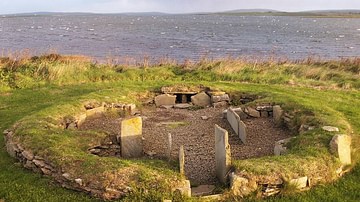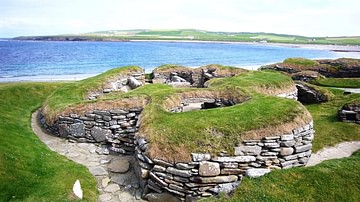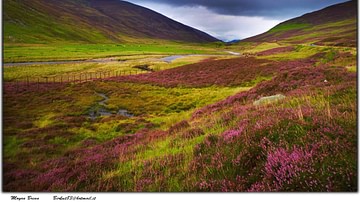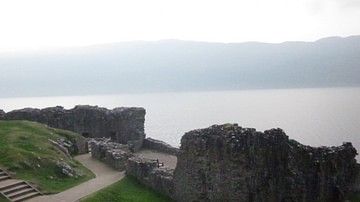
The Ness of Brodgar is a Neolithic Age site discovered in 2002 CE through a geophysical survey of the area of land in Stenness in Orkney, Scotland, which separates the salt water Stenness Loch from the fresh water Harray Loch. Excavation of the site, which covers 6.2 acres (2.5 hectares), began in 2003 CE, when a stone slab was ploughed up north of the site, and is ongoing with only 10% of the area excavated as of 2012 CE. This site is considered one of the most important finds in recent archaeology as it pre-dates both Stonehenge and the Pyramids of Giza, dating from around 3500 BCE (the pyramids date from c. 2560 BCE and Stonehenge from c. 3000-2400 BCE). Perhaps more importantly, this site provides a context for other famous Neolithic sites in the surrounding area, particularly the Ring of Brodgar and the Standing Stones of Stenness. The Ness of Brodgar is listed by UNESCO as a World Heritage Site.
Less than one mile (1.6 km) north of the Ness of Brodgar the Ring of Brodgar stands, huge monoliths erected in the patterned circle of a henge, long understood as having served in rituals concerning the dead and the afterlife. To the south, less than one mile, are the Standing Stones of Stenness, also a henge, which has been interpreted as involving ceremonies concerning the land of the living. The surrounding area comprises such famous sites as Maeshowe, The Barnhouse Stone, The Unstan Tomb, Comet Stone, Watchstone and, to the north, the Ring of Bookan and Skara Brae, all dated to the Neolithic Age. With such a close concentration of Neolithic monuments it would not be surprising to uncover a large settlement from the same period and yet archaeologists are currently claiming, based on the excavations completed thus far, that the Ness of Brodgar primarily served, not the living, but the dead.
According to National Geographic Magazine, “Archaeologist Mark Edmonds thinks that thousands of years ago, the Ness was a place where Orkney's Neolithic farming communities gathered in large numbers for seasonal rituals and to commemorate the dead…The complexes also all appear to share a common layout, roughly speaking. `We get the impression that they not only have places where the dead are congregated and where the ceremonial events take place, but there are also places where the living congregate'.” It is thought that the Ness of Brodgar was a liminal site between the land of the living, symbolized by the Stones of Stenness, and the land of the dead at the Ring of Brodgar. That the Ness of Brodgar site was not a domestic settlement is supported by an absence of any of the usual evidence of daily activity in and around the buildings excavated thus far. There are no middens and no signs of family or community life. Rather, all evidence points to the buildings serving a strictly ritualistic, ceremonial, purpose.
Over one hundred structures remain buried at the site, according to the initial survey, and are surrounded by an immense wall which rose over thirteen feet (3.9 metres) and had openings only in the north and south sides. These entrances/exits correspond precisely to the point north of the Ring of Brodgar and the point south of the Stones of Stenness. In 2008 CE, excavations revealed the largest Neolithic structure ever found in Britain (known as Structure Ten) which measured 82x65 feet (25x20 metres) and was neither a tomb nor a domicile. Four stone `dressers' have been found in Structure Ten which archaeologists speculate may have been used as altars. Further evidence uncovered in 2010 CE indicates the use of paint in decorating the walls of the structures and slate tiles as roofing material.
Many more finds of interest, such as the small statue known as `Brodgar Boy', have been uncovered but the archaeologists involved with the excavation have made it clear that they have hardly begun the work of unearthing and interpreting the site. Excavations and site director, Nick Card, has observed that “Orkney is one of the keys to understanding the development of Neolithic religion” and, regarding the Ness of Brodgar, “We're still really just scratching the surface.” Work is expected to continue at the site for decades as archeologists reconstruct the immense complex and interpret the original purpose of those who built it. Excavators concede that the present theory of a liminal passage between the worlds of the living and the dead could certainly be re-evaluated as excavations progress, though presently, this theory appears to be sound based upon the established sites in the vicinity.




